|
Various freshwater snails
|
As apple snails are only a small part of the snail species that inhabit aquaria
and ponds around the world, thus some basic information on other common freshwater
snails cannot be left away.
This overview is by no means complete and it is therefore advised to take a
look at other websites as well to gather more specific information (see link
section) as well. Remarks, suggestions or questions about this section (or other
sections) can be send to the author by using the question
form.
Here is a small guide to facilitate to determination of your aquarium freshwater
snails.
Please bear in mind that this guide is by no means complete. It's only intended
to give a rough overview to help you in the right direction. For more specific
information, you should use more specialized literature.
|
Determination guide
|
||||||||||||||||||||||||||||||||||||||||||||||||||
Subclass Pulmonata
The snails from this family don't have a classic, spiral shell, but a
hood-shaped shell.
The Acroloxidae family consists of 2 genera: the genus Acroluxus with
5 species (North America, Europe and northern East Asia) and the genus Pseudancylastrum
with 3 species (all endemic to Lake Baikal).
The size of these snails varies from 2 mm to 8 mm. The snails present themselves
as small white spots on the plants and the glass. They are not considered to
be harmful, although large numbers of these can be annoying when they cover
whole parts of the glass. However, as with all snails, if the availability of
food is reduced, the population of these snails will decrease as well.
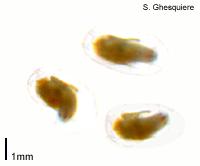 Acroloxus lacustris, light from underside. |
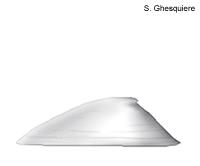 Acroloxus lacustris, sideview. |
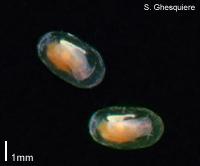 Acroloxus lacustris, reflecting light source. |
The nomenclature of the Lymnaeidae is still somewhat unclear.
The family is divided in two generally accepted subfamilies: Lancinea en Lymnaeinae.
The Lancinea subfamily is abundant in western North America (Columbia, Umpaqua,
Klamath and Sacramento River drainage) and consists of the genera Fisherola
with one species and Lanx with four species in two subgenera.
There is much disagreement about the nomenclature of the cosmopolitan Lymnaeinae
subfamily. Some authors only accept one genus (Lymnea), while others prefer to up
to 7 different genera (Galba, Stagnicola, Radix, Lymnea s.s.
and other genera).
Respiration in these snails is aerial, through lungs. Their preferred
habitats are stagnant to slow streaming waters with heavy vegetation.
Both the shell as well the body of the snail are dextral, which means that the
shell opening is situated at the right if one looks at the shell with the top
pointed upwards and the shell opening visible. The lung opening at the right
side of the body indicates the dextral body structure.
The transparant eggs are deposited in a firm, gelatinous clutch on plants, stones or other
objects. These snails are hermaphroditic and two snails are enough to get large numbers of
them in relatively short time.
The size of these snails varies from 1 cm (Lymnea truncata, Müller), 3 cm (Lymnea
peregra, Müller) to 7 cm (Lymnea stagnata, Linnaeus).
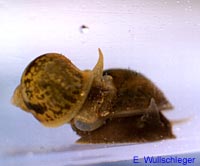 Mating Lymnea (radix) ovata snails. (picture not licenced under creative commons) |
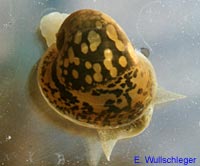 Lymnea (radix) auricularia. (picture not licenced under creative commons) |
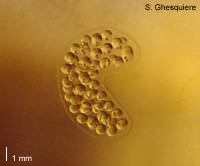 Lymnea stagnalis, eggs. |
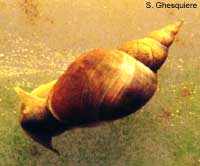 Lymnea stagnalis (giant pond snail). |
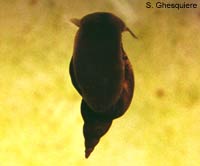 Lymnea stagnalis, size: 3.5 to 7.0 cm. |
The Physidae family is native to Europe, North Asia, North and Middle
America and western Africa.
Four genera are generally accepted: Physa, Physella, Aplexa (Europe, America,
Asia and Africa) and Stenophysa (Central America).
The snails from this family have a sinistral shell (left turned)
and body (lung opening at the left) and a mantle skirt with two lobes embracing
the shell at the left and at the right side of the body. This mantle extension
enlarges the body surface; probably to enhance the exchange of O2
and CO2 (sort of a gill function), which enables these
pulmonates to stay submerged for longer periods.
These snails lay transparant eggs that are embedded in a firm, gelatinous clutch on
plants, stones or other objects.
The size of snail in the Physa genus varies from 13 mm (Physa fontinalis) to 20
mm (Physa acuta).
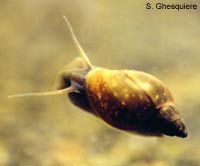 Physa acuta, size: 12 mm. |
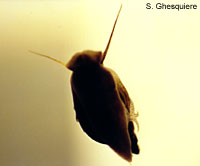 Physa acuta with the left mantle lobe visible. |
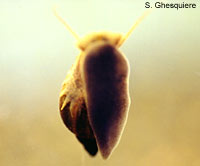 Physa acuta with the right mantle lobe visible. |
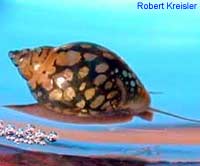 Physa spec. woth beautiful mantle pigmentation, visible through the fragile shell. (picture not licenced under creative commons) |
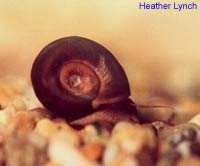 Planorbis species (Ramshorn snail). (picture not licenced under creative commons) |
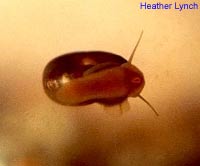 Planorbis spec. (Ramshorn snail). (picture not licenced under creative commons) |
The Planorbidae are by far the largest family of aquatic pulmonates that
are widely distributed over the world.
Three subfamilies are recognised in the Planorbidae: Rhodacmeinae, Buliniae and
Planorbinae, the latter two are subdivided in tribes, each consisting of several genera.
However, there is much discussion about many of the genera and the species. Many genera
and species are considered to be invalid and synonyms of each other by several authors.
The subfamily Rhodacmeina contains one genus with three species that all live in the Tombigbee (Alabama) and Tennessee river drainage in the southeastern U.S.A.
The widely distributed subfamily Buliniae consists of three tribes:
- Bulinini with four genera: Bulinus (Africa, Madagascar, western Asia and
southern Europe), Indoplanorbis (southern Asia), Laevapex (eastern North
America) and Gundlachia (South and Middle America).
- Physastrini with possibly 12 valid genera: Glyptophysa (south-eastern
Australia, Tasmania, New Zealand and New Caledonia), Physastra (Australia, New
Zealand, New Caledonia, Sumatra, Philippines and several Pacific islands), Ameriana
(north and north-east Australia, New Guinea, Indonesia, Thailand and the Philippines), Barnupia
(tropical Africa), Ferresia (North America), Pettancyclus (Australia,
New Zealand, East and southern Asia and eastern Africa), Isidorella (western and
southern Australia), Bayardella (Australia), Patelloplanorbis (New
Guinea), Oppletora (north Australia), Ancylastrum (Tasmania) and Miratesta
(Indonesia).
- Camproceratini with two genera: Helisoma in North America and Planorbarius
(North America, Europe and northern Asia).
The subfamily Planorbinae consists of five tribes:
- Planorbulini with 1 genus: Planorbula (North America). However, according
some authors, this tribe also includes the genera Menetis, Promenetus
and Planorbella.
- Biomphalariini with 2 genera: Biomphalaria (Africa, Madagascar, South
and Middle America, Western Asia and Europe) and Drepanotrema (South
and Middle America).
- Planorbini with 7 genera: Planorbis (Europe and western Siberia),
Afrogyrus (tropical Africa and Madagascar), Afrogyrorbis (tropical
Africa), Anisus (Europe and western Siberia), Bathyomphalus
(Europe and Northern Asia), Gyraulus (Europe, Northern and East Asia,
Africa and Australia) and Choanomphalus (western Siberia rivers, Volga
local population in Lakes).
- Segmentini with 6 genera: Segmentina (Europe and northern Asia),
Hippeutis (Europe and northern Asia), Lentorbis (tropical
Africa), Polypylis (East Asia) and Helicorbis (East Asia).
- Ancylini with one genus: Ancylus (North America, Northern Europe
and Northern Asia).
Most Planorbidae have a flat shell, somewhat similar to a ramshorn
in shape, hence their common name ramhorn snails. However, not all snail
with this shape are Planorbidae, for example the Ampullariidae
genus Marisa has a similar shell shape.
The shell of many Planorbidae is right turned (dextral), but their body is sinistral,
a situation similar with the Lanistes genus
of the Ampullariidae (apple snails), which have a sinistral
shell and dextral body. Because collected shells are often empty, these snails
are considered dextral for practical, determination reasons, but on anatomical
grounds one could call these snail hyperstrophic dextral. On the other hand,
some Planorbidae genera like Ameriana and Physastra from the
Physastrini tribe have sinistral, globose conic shells, while the Ancylus
genus have flat hood-shaped shells, similar to the Acroloxidae snails.
The eggs of these hermaphroditic Planorbidae snails are laid in
transparant clutches on plants, stones or other objects.
Most Planorbidae members prefer habitats with slow moving or stagnant waters
like ponds, lakes and swamps.
Subclass Prosobranchia
The species Melanoides tuberculata (Müller, 1774) and
Melanoides granifera (Lamarck, 1822) are the best know species of this
family and occur in almost all aquaria around the world.
The Thiaridae are cosmopolitan freshwater snails. Most species of this family
crawl through the mud in search for food, a life style that makes them attractive
to keep in aquaria as they loosen the soil. It also makes these snails quite
conspicuous and the best changes to see them are during the night and when overcrowding
has occurred. In the latter case, overfeeding of the fish in the aquarium might
have caused an excessive population growth of snails.
Their toughness is probably the principal reason of their success both in the
wild as in the aquaria world. The horny operculum of these snails enables them
to close their shell to protect them against drought and predators. They can
easily survive periods of drought for months, hidden in the bottom.
Another thing that contributes to their ability to survive is the strength and
thickness of their shell; most snail eating fish, as well as many other predators
are not able to crush their shell. Even predators that swallow them whole won't
always benefit from their meal as these snails can sometimes survive a trip
through the intestines. This is a great advantage for these snails as they can
spread to new areas after being eaten by a bird and expelled with the faeces.
One of the most remarkable features of these snails is their parthogenetic reproduction:
unfertilised females are able to reproduce. So only one snail is needed to have
more in short time.
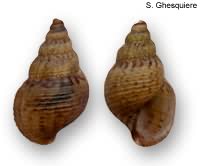 Melanoides granifera. |
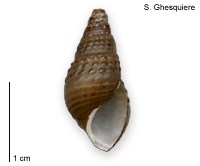 Melanoides granifera. |
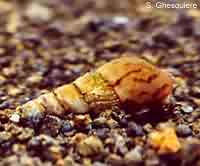 Melanoides tuberculata. |
Genera:
- Aylacostoma: Central and South America
- Cubaedomus: Cuba
- Dorissa: South America
- Fijidoma: Fiji Islands
- Hemisinus: South America
- Melanatria: Madagascar
- Melanoides: Southern Europe, Africa Terebia; south Asia, Oceania
- Pseudopotamis: Australia
- Sermyla: southeast Asia, Oceania
- Sermylasma: Australia
- Thiara: East Africa to Polynesia, some species also very wide ranging
- Tylomelania: Celebes
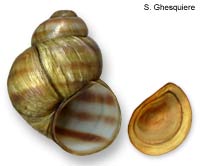 Viviparus viviparus (Linnaeus). |
Viviparidae have a worldwide distribution.
Subfamily Viviparinae:
- Viviparus: Eastern North America and most of Europe.
- Tulatoma: endemic in Coosa River, Alabama, USA.
Campelominae or Lioplacinae:
- Campeloma: Eastern North America.
- Lioplax; Eastern North America.
Bellamyinae:
- Bellamyia: Africa, India, southeast Asia.
- Cipangopaludina: east and southeast Asia, and as an exotic elsewhere.
- Notopala: eastern Australia. Larina; northeast Australia.
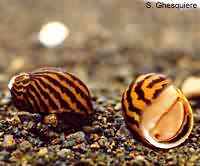 Neritina natalensis (Reeve, 1845), a South-African freshwater species. |
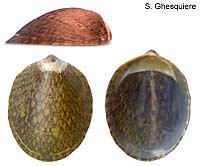 Septaria species (Freshwater limpet). |
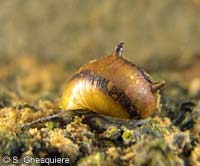 Unknown freshwater nerite. Possible origin: Pangandaran, Java? |
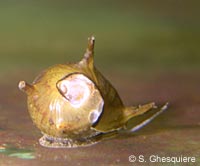 Unknown freshwater nerite. |
Most members of the Neritidae family are salt-water snails, but some species
have adapted to brackish and even freshwater environments.
The drop-like shape of their shell makes it easy to distinct these snails from
most other freshwater snails. The often beautiful and attractive colour pattern
of their shell is differs from the generally conspicuous appearance of most
other freshwater snails.
The Neritidae have separated sexes and the small white eggs are deposited
on rocks, the glass and other solid objects. The growth of these snails is fairly
slow, which explains why these snails are often more expensive the fast growing
snails like apple snails.
For the aquarist these snails are an attractive choice, both by their look as
for algae control. They have not much appetite for plants, whilst algae aren't
safe for them.
Despite these snails are not always easy obtain, several species are occasionally
offered in the aquarium trade.
- Clypeolum: widespread in the tropical Pacific basin.
- Fluvionerita: mountain brooks of Jamaica.
- Neritilia: all tropical regions.
- Neritina: tropical Atlantic coasts, Indo-Pacific.
- Neritodryas: Malay archipelago.
- Septaria: rivers and streams of large South-Pacific islands, Madagascar,
India.
- Theodoxus: Europe and southwestern Asia.
However, there is no complete agreement between the different authors regarding the genera and ranges given for their included species.
More info?
Take a look at these sites:
- Freshwater
Molluscan Shells by Martin Kohl for good info about species, genera etc.
With lots of photographs.
- Heather's
snail website Contains well observed and descibed info of snail behaviour
in Physidae snails.
- The domain of the
Ampullariidae: Not only Ampullariidae snail are listed here, also a valuable
collection of all kinds of freshwater snail info can be found here. One of the
better websites on snails around....
- Man and Mollusc.
The Resource Site for Students, Educators, and anyone wanting to learn more
about the fascinating world of, the Molluscs.
|
Except where otherwise noted, this page is licensed under a Creative Commons Attribution-NonCommercial-ShareAlike 2.5 License . http://www.applesnail.net |
|